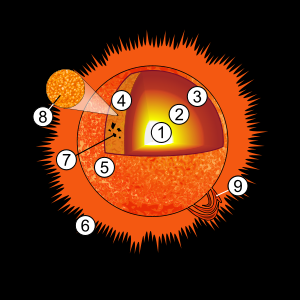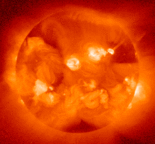- Convection zone
-
 An illustration of the structure of the Sun:
An illustration of the structure of the Sun:
1. Core
2. Radiative zone
3. Convective zone
4. Photosphere
5. Chromosphere
6. Corona
7. Sunspot
8. Granules
9. ProminenceThe convection zone of a star is the range of radii in which energy is transported primarily by convection. In the radiation zone, energy is transported by radiation. Stellar convection consists of mass movement of plasma within the star which usually forms a circular convection current with the heated plasma ascending and the cooled plasma descending.
The Schwarzschild criterion expresses the conditions under which a region of a star is unstable to convection. A parcel of gas that rises slightly will find itself in an environment of lower pressure than the one it came from. As a result, the parcel will expand and cool. If the rising parcel cools to a lower temperature than its new surroundings, so that it has a higher density than the surrounding gas, then its lack of buoyancy will cause it to sink back to where it came from. However, if the temperature gradient is steep enough (i. e. the temperature changes rapidly with distance from the center of the star), or if the gas has a very high heat capacity (i. e. its temperature changes relatively slowly as it expands) then the rising parcel of gas will remain warmer and less dense than its new surroundings even after expanding and cooling. Its buoyancy will then cause it to continue to rise. The region of the star in which this happens is the convection zone.
In stars more than 1.3 times the mass of the Sun, the nuclear fusion of hydrogen into helium occurs via CNO cycle instead of the proton-proton chain. The CNO process is very temperature sensitive, so the core is very hot but the temperature falls off rapidly. Therefore, the core region forms a convection zone that uniformly mixes the hydrogen fuel with the helium product. The core convection zone of these stars is overlaid by a radiation zone that is in thermal equilibrium and undergoes little or no mixing.[1]
In stars of less than about 10 solar masses, the outer envelope of the star contains a region where partial ionization of hydrogen and helium raises the heat capacity. The relatively low temperature in this region simultaneously causes the opacity due to heavier elements to be high enough to produce a steep temperature gradient. This combination of circumstances produces an outer convection zone, the top of which is visible in the sun as solar granulation. Low mass main sequences of stars, such as red dwarfs, as well as pre-main sequence stars on the Hayashi track, are convective throughout and do not contain a radiation zone.
Contents
See also
References
- ^ Brainerd, Jim (February 16, 2005). "Main Sequence Stars". The Astrophysics Spectator. http://www.astrophysicsspectator.com/topics/stars/MainSequence.html. Retrieved 2007-11-25.
General References
- Hansen, C. J., Kawaler, S. D., & Trimble, V. (2004). Stellar Interiors. Springer. ISBN 0387200894.
- Zeilik, M. & Gregory, S. A. (1998). Introductory Astronomy and Astrophysics. Brooks Cole. ISBN 9780030062285.
External links
- Animated explanation of the Convection zone (University of Glamorgan).
- Animated explanation of the temperature and density of the Convection zone (University of Glamorgan).
The Sun Internal structure - Core
- Radiation zone
- Convection zone

Atmosphere - Transition region
- Coronal hole
- Coronal loop
- Coronal mass ejection
- Prominence
- Helmet streamer
Variation Heliosphere Related topics Spectral class: G2 Categories:
Wikimedia Foundation. 2010.

